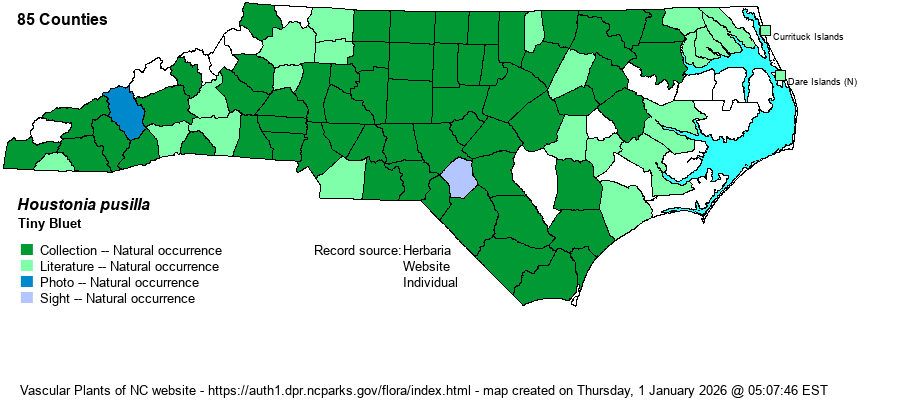| Author | Schoepf | |
| Distribution | Formerly mostly in the Piedmont and western Coastal Plain, but is rapidly spreading (often in lawns) across most of the state now -- with numerous photographic records. Probably still "absent" in a few coastal counties and a few mountain counties.
This is a Southern species, ranging from MD and KS, south to western FL and central TX. | |
| Abundance | Common and increasing statewide, especially in the central and eastern Piedmont and western Coastal Plain. Less common in the central Coastal Plain and in the far eastern counties, but clearly spreading coastward. Uncommon in the Mountains and western Piedmont, but increasing there. The NCNHP's State Rank of S4 is clearly incorrect, as it is certainly an S5 species in the state. | |
| Habitat | This species, as with H. caerulea, grows in dry clay or sandy soil without much competition. It is found in roadsides, fields, lawns, margins of trails, edges of woods, and other places with low vegetation. | |
| Phenology | Blooms in March and April, and fruits soon after flowering. | |
| Identification | This is a familiar species except for people in the eastern and mountain parts of the state, quite easily found in spring in compacted, dry soil. It is extremely slender, reaching only about 3 inches tall on average, with some spatulate basal leaves only about 1/2-inch long. There are only one or two pairs of tiny, opposite stem leaves. The single flower atop the stem or any branches has 4 spreading petals, but the flower is only about 1/4-inch across, being darker lavender blue, with a dark red eye. H. caerulea is similar but slightly taller and has a slightly larger flower that is light blue with a yellow eye. As with that species, normally a few dozen plants can grow in a small patch of ground. Note that a few flowers, or populations, can have a "pale morph" where the eye is yellow or white and the petals are light blue -- i.e., the "purple" tint to the flower is absent, and the flower color is nearly identical to that of H. caerulea. However, this latter species has larger flowers, a taller stem, and longer leaves. | |
| Taxonomic Comments | Some references use the genus name of Hedyotis, but most use Houstonia.
| |
| Other Common Name(s) | Small Bluet(s) | |
| State Rank | S4 [S5] | |
| Global Rank | G5 | |
| State Status | | |
| US Status | | |
| USACE-agcp | FACU link |
| USACE-emp | FAC link |

